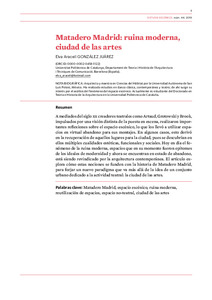Matadero Madrid: Modern Ruin, City of the Arts
Metadata
Show full item record
Estudis escènics: quaderns de l'Institut del Teatre. 2019, Núm. 44
Document typeArticle
Abstract
<p>In the mid-20th century theatre creators such as Artaud, Grotowski and Brook, driven by a different vision of the mise-en-scène, developed major reflections on the performing space, which took them to use abandoned spaces for their productions. In some cases, this led to the recovery of those places for the city because multiple aesthetic, functional and social qualities were found in them. Today the phenomenon of modern ruins, spaces which in their time were epitomes of the ideals of modernity and are now in a state of abandonment, is being defended by contemporary architecture. The article explores how these notions fuse with the history of Matadero Madrid to forge a new paradigm that goes beyond the idea of an urban site devoted to theatre activity: the city of the arts.</p> <p>A mediados del siglo xx creadores teatrales como Artaud, Grotowski y Brook, impulsados por una visión distinta de la puesta en escena, realizaron importantes reflexiones sobre el espacio escénico, lo que los llevó a utilizar espacios en virtual abandono para sus montajes. En algunos casos, esto derivó en la recuperación de aquellos lugares para la ciudad, pues se descubrían en ellos múltiples cualidades estéticas, funcionales y sociales. Hoy en día el fenómeno de la ruina moderna, espacios que en su momento fueron epítomes de los ideales de modernidad y ahora se encuentran en estado de abandono, está siendo revindicado por la arquitectura contemporánea. El artículo explora cómo estas nociones se funden con la historia de Matadero Madrid, para forjar un nuevo paradigma que va más allá de la idea de un conjunto urbano dedicado a la actividad teatral: la ciudad de las artes.</p>
Access conditionsOpen Access
ISSN2385-362X
,
0212-3819
Collections
- 2019: Núm.: 44 [22]


